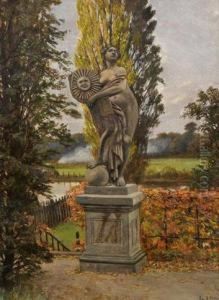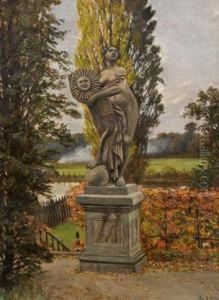August Heinrich Plinke Paintings
August Heinrich Plinke was a German artist known primarily for his landscape paintings, capturing the serene beauty of nature with a remarkable sensitivity to light and atmosphere. Born on May 23, 1829, in Hanover, Germany, Plinke showed an early interest in art, which led him to pursue studies at the Academy of Fine Arts in Düsseldorf, a leading art school of the time that emphasized detailed, realistic, and romanticized depictions of nature and historical scenes. Under the tutelage of famous painters such as Johann Wilhelm Schirmer and Carl Friedrich Lessing, Plinke honed his skills and developed his distinctive style, which combined meticulous detail with a romantic sensibility.
Throughout his career, Plinke was deeply influenced by the natural surroundings of his homeland as well as his travels across Europe. His works often depict the German countryside, featuring forests, rivers, and rural scenes that evoke a sense of tranquility and timelessness. Plinke's paintings are characterized by their detailed vegetation, subtle interplay of light and shadow, and a palette that captures the changing seasons and times of day with remarkable accuracy.
Despite his considerable talent, Plinke remained relatively obscure during his lifetime, overshadowed by his contemporaries in the Düsseldorf school. However, his dedication to landscape painting contributed to the development of the genre in Germany and influenced subsequent generations of artists. After his death on December 1, 1899, in Düsseldorf, Plinke's work gained recognition for its contribution to 19th-century German art, securing him a place among the notable landscape painters of his era.
Today, August Heinrich Plinke's paintings are appreciated for their serene beauty and technical skill. His works can be found in various art collections and museums across Germany and Europe, serving as a testament to his passion for the natural world and his mastery of the landscape genre.

